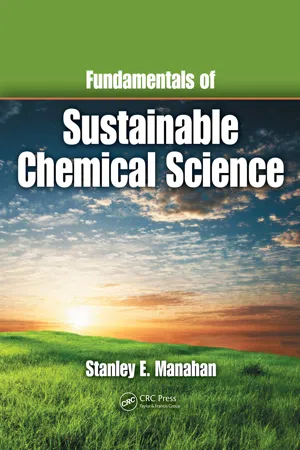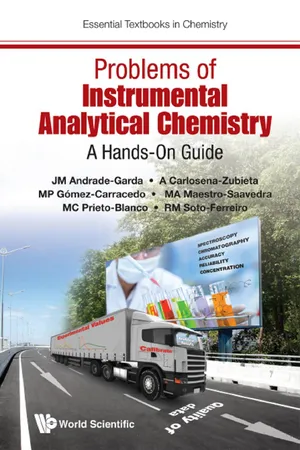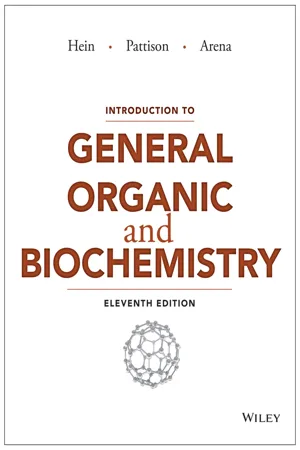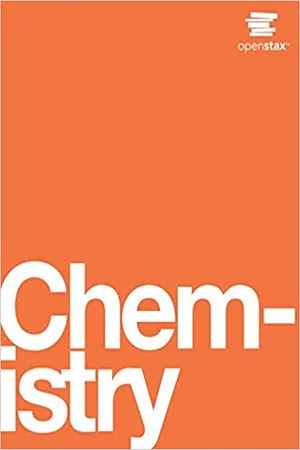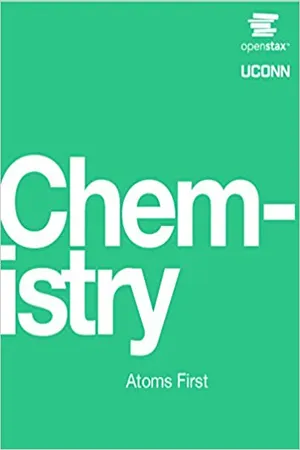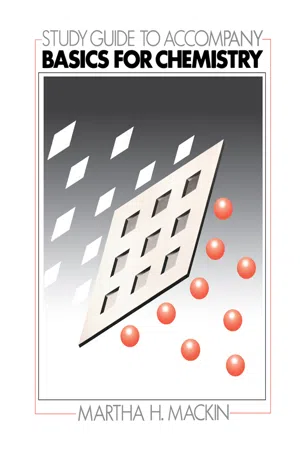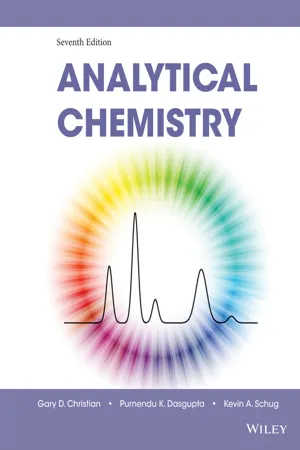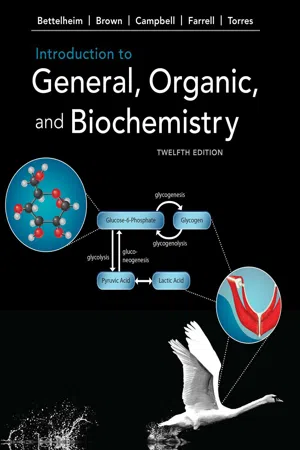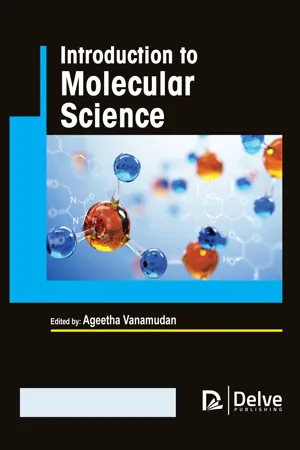Chemistry
Chemical Calculations
Chemical calculations involve using mathematical principles to determine quantities of substances involved in chemical reactions. This includes stoichiometry, which involves calculating the amount of reactants and products in a chemical reaction, as well as determining the concentration of solutions and performing various types of chemical conversions. These calculations are essential for understanding and predicting chemical reactions.
Written by Perlego with AI-assistance
Related key terms
1 of 5
12 Key excerpts on "Chemical Calculations"
- eBook - PDF
- Morris Hein, Susan Arena, Cary Willard(Authors)
- 2021(Publication Date)
- Wiley(Publisher)
184 Calculations from Chemical Equations CHAPTER OUTLINE 9.1 Introduction to Stoichiometry 9.2 Mole–Mole Calculations 9.3 Mole–Mass Calculations 9.4 Mass–Mass Calculations 9.5 Limiting Reactant and Yield Calculations The old adage “waste not, want not” is appropriate in our daily life and in the laboratory. Determining correct amounts comes into play in almost all professions. A seamstress determines the amount of material, lining, and trim necessary to produce a gown for her client by relying on a pat- tern or her own experience to guide the selection. A carpet layer deter- mines the correct amount of carpet and padding necessary to recarpet a customer’s house by calculating the floor area. The IRS determines the correct deduction for federal income taxes from your paycheck based on your expected annual income. In chemistry, calculations from chemical equations are important too. These same calculations and amounts are used frequently in medi- cine and pharmacy. Accurate calculations of dose and accurate measure- ment of chemicals are required in order for a pharmacist or a nurse to dispense the correct dosage of medicine to her patients. CHAPTER 9 Pyrosky/iStock/Getty Images 9.1 Introduction to Stoichiometry 185 9.1 Introduction to Stoichiometry LEARNING OBJECTIVE: Define stoichiometry and describe the strategy required to solve problems based on chemical equations. We often need to calculate the amount of a substance that is either produced from, or needed to react with, a given quantity of another substance. The area of chemistry that deals with quantitative relationships among reactants and products is known as stoichiometry (stoy-- key-- ah-- meh-- tree). Solving problems in stoichiometry requires the use of moles in the form of mole-ratios. The chemist also finds it necessary to calculate amounts of products or reactants by using a balanced chemical equation. - eBook - PDF
- Stanley E. Manahan(Author)
- 2009(Publication Date)
- CRC Press(Publisher)
Among the of the basic Chemical Calculations early in a beginning chemistry course. Among the most important of these are the calculations of the quantities of substances consumed most important of these are the calculations of the quantities of substances consumed or produced in a chemical reaction. Such calculations are classified as or produced in a chemical reaction. Such calculations are classified as stoichiometry stoichiometry . . Heat is normally evolved or taken up in the course of a chemical reaction. The cal-Heat is normally evolved or taken up in the course of a chemical reaction. The cal-culation of the quantity of heat involved in a reaction falls in the branch of chemistry culation of the quantity of heat involved in a reaction falls in the branch of chemistry called called thermochemistry thermochemistry . 5.2. THE INFORMATION IN A CHEMICAL EQUATION 5.2. THE INFORMATION IN A CHEMICAL EQUATION Chemical Reactions Chemical Reactions A chemical reaction is a process involving the breaking and/or formation of A chemical reaction is a process involving the breaking and/or formation of chemical bonds and a change in the chemical composition of the materials partici-chemical bonds and a change in the chemical composition of the materials partici-pating in the reaction. A chemical reaction might involve the combination of two pating in the reaction. A chemical reaction might involve the combination of two elements to form a compound. An example of this is the reaction of elemental hydro-elements to form a compound. An example of this is the reaction of elemental hydro-gen and oxygen to produce the compound water. Passage of an electrical current gen and oxygen to produce the compound water. Passage of an electrical current through water can cause the compound to break down and produce elemental hydro-through water can cause the compound to break down and produce elemental hydro-gen and oxygen. - eBook - PDF
- Morris Hein, Susan Arena, Cary Willard(Authors)
- 2016(Publication Date)
- Wiley(Publisher)
T he old adage “waste not, want not” is appropriate in our daily life and in the laboratory. Determining cor- rect amounts comes into play in almost all professions. A seamstress determines the amount of material, lining, and trim necessary to produce a gown for her client by rely- ing on a pattern or her own experience to guide the selec- tion. A carpet layer determines the correct amount of carpet and padding necessary to recarpet a customer’s house by calculating the floor area. The IRS determines the correct deduction for federal income taxes from your paycheck based on your expected annual income. In chemistry, calculations from chemical equations are important too. These same calculations and amounts are used frequently in medicine and pharmacy. Accurate calculations of dose and accurate measurement of chemicals are required in order for a pharmacist to dispense the correct dosage of medicine to her patients. Calculations from Chemical Equations Corbis RF/Age Fotostock America, Inc. 9 C H A P T E R O U T L I N E 9.1 Introduction to Stoichiometry 9.2 Mole–Mole Calculations 9.3 Mole–Mass Calculations 9.4 Mass–Mass Calculations 9.5 Limiting Reactant and Yield Calculations 176 CHAPTER 9 Calculations from Chemical Equationss 9.1 Introduction to Stoichiometry Define stoichiometry and describe the strategy required to solve problems based on chemical equations. We often need to calculate the amount of a substance that is either produced from, or need- ed to react with, a given quantity of another substance. The area of chemistry that deals with quantitative relationships among reactants and products is known as stoichiometry (stoy-key-ah-meh-tree). Solving problems in stoichiometry requires the use of moles in the form of mole ratios. The chemist also finds it necessary to calculate amounts of products or reactants by using a balanced chemical equation. - eBook - ePub
Problems of Instrumental Analytical Chemistry
A Hands-On Guide
- JM Andrade-Garda, A Carlosena-Zubieta;MP Gómez-Carracedo;MA Maestro-Saavedra;MC Prieto-BlancoRM Soto-Ferreiro(Authors)
- 2017(Publication Date)
- WSPC (EUROPE)(Publisher)
The calculations reflect the different stages of the analytical process and, so, the more complex the analytical procedures become, the more intertwined the required calculations will be. In general, calculations are not too complex although it is essential to understand what is going on chemically in each step of the analysis. This would allow students to establish the appropriate mathematical relationships between the various stages of the analytical process.To achieve satisfactory learning outcomes, you should be able to understand and justify every operation or calculation rather than only performing them mechanically, so that you yourself should be able to detect any gross error in the final solution. There is no single ‘magic’ formula to solve all exercises. Students have to learn problem-solving strategies and start developing some chemical intuition (’the chemical criterion’). This means that they must develop critical thinking skills to succeed in their professional lives.A fundamental starting point that falls outside the scope of this book is that the students should know how to formulate (and name) all the compounds involved in the exercises to correctly write and balance the chemical reactions. (S)He has to know how to perform the necessary basic stoichiometric calculations. Without this essential background, (s)he will not achieve satisfactory results in their degrees or, worse, they will fail as chemists. When the compounds mentioned into the numerical exercises are not of common use, their chemical structure will be shown. This will be particularly so in Chapter 6 .1.1.Relevant units and expressions of concentration
Initially, it is worth starting this chapter by presenting some basic recommendations. As a general rule, scientific notation must be used in order to avoid working with very large or very small numbers, being advisable to obtain a number between 1 and 10, and to express its magnitude through an exponent. Thus, large numbers have positive exponents and small numbers have negative exponents. - Morris Hein, Scott Pattison, Susan Arena, Leo R. Best(Authors)
- 2014(Publication Date)
- Wiley(Publisher)
12.1 • Properties of Gases 167 Corbis RF/Age Fotostock America, Inc. T he old adage “waste not, want not” is appropriate in our daily life and in the laboratory. Determining correct amounts comes into play in almost all professions. A seamstress determines the amount of material, lining, and trim necessary to produce a gown for her client by relying on a pattern or her own experience to guide the selection. A carpet layer de- termines the correct amount of carpet and padding necessary to recarpet a customer’s house by calculating the floor area. The IRS determines the correct deduction for federal income taxes from your paycheck based on your expected annual income. 9.1 Introduction to Stoichiometry 9.2 Mole–Mole Calculations 9.3 Mole–Mass Calculations 9.4 Mass–Mass Calculations 9.5 Limiting Reactant and Yield Calculations CALCULATIONS FROM CHEMICAL EQUATIONS C H A P T E R 9 Accurate calculations of dose and accurate measurement of chemicals are required in order for a pharmacist to dispense the correct dosage of medicine to her patients. C H A P T E R O U T L I N E 168 CHAPTER 9 • Calculations from Chemical Equations 9.1 INTRODUCTION TO STOICHIOMETRY Define stoichiometry and describe the strategy required to solve problems based on chemical equations. We often need to calculate the amount of a substance that is either produced from, or needed to react with, a given quantity of another substance. The area of chemistry that deals with quantitative relationships among reactants and products is known as stoichiometry (stoy-key-ah-meh-tree). Solving problems in stoichiometry requires the use of moles in the form of mole ratios. The chemist also finds it necessary to calculate amounts of products or reactants by using a balanced chemical equation. With these calculations, the chemist can control the amount of product by scaling the reaction up or down to fit the needs of the laboratory and can thereby minimize waste or excess materials formed during the reaction.- eBook - PDF
- Paul Flowers, Klaus Theopold, Richard Langley, William R. Robinson(Authors)
- 2015(Publication Date)
- Openstax(Publisher)
The amount of product generated by a chemical reaction is its actual yield. This yield is often less than the amount of product predicted by the stoichiometry of the balanced chemical equation representing the reaction (its theoretical yield). The extent to which a reaction generates the theoretical amount of product is expressed as its percent yield. 4.5 Quantitative Chemical Analysis The stoichiometry of chemical reactions may serve as the basis for quantitative chemical analysis methods. Titrations involve measuring the volume of a titrant solution required to completely react with a sample solution. This volume is then used to calculate the concentration of analyte in the sample using the stoichiometry of the titration reaction. Gravimetric analysis involves separating the analyte from the sample by a physical or chemical process, determining its mass, and then calculating its concentration in the sample based on the stoichiometry of the relevant process. Combustion analysis is a gravimetric method used to determine the elemental composition of a compound by collecting and weighing the gaseous products of its combustion. Chapter 4 | Stoichiometry of Chemical Reactions 213 Exercises 4.1 Writing and Balancing Chemical Equations 1. What does it mean to say an equation is balanced? Why is it important for an equation to be balanced? 2. Consider molecular, complete ionic, and net ionic equations. (a) What is the difference between these types of equations? (b) In what circumstance would the complete and net ionic equations for a reaction be identical? 3. Balance the following equations: (a) PCl 5 (s) + H 2 O(l) ⟶ POCl 3 (l) + HCl(aq) (b) Cu(s) + HNO 3 (aq) ⟶ Cu(NO 3 ) 2 (aq) + H 2 O(l) + NO(g) (c) H 2 (g) + I 2 (s) ⟶ HI(s) (d) Fe(s) + O 2 (g) ⟶ Fe 2 O 3 (s) (e) Na(s) + H 2 O(l) ⟶ NaOH(aq) + H 2 (g) (f) (NH 4 ) 2 Cr 2 O 7 (s) ⟶ Cr 2 O 3 (s) + N 2 (g) + H 2 O(g) (g) P 4 (s) + Cl 2 (g) ⟶ PCl 3 (l) (h) PtCl 4 (s) ⟶ Pt(s) + Cl 2 (g) 4. - eBook - PDF
- William R. Robinson, Edward J. Neth, Paul Flowers, Klaus Theopold, Richard Langley(Authors)
- 2016(Publication Date)
- Openstax(Publisher)
The amount of product generated by a chemical reaction is its actual yield. This yield is often less than the amount of product predicted by the stoichiometry of the balanced chemical equation representing the reaction (its theoretical yield). The extent to which a reaction generates the theoretical amount of product is expressed as its percent yield. 7.5 Quantitative Chemical Analysis The stoichiometry of chemical reactions may serve as the basis for quantitative chemical analysis methods. Titrations involve measuring the volume of a titrant solution required to completely react with a sample solution. This volume is then used to calculate the concentration of analyte in the sample using the stoichiometry of the titration reaction. Gravimetric analysis involves separating the analyte from the sample by a physical or chemical process, determining its mass, and then calculating its concentration in the sample based on the stoichiometry of the relevant process. Combustion analysis is a gravimetric method used to determine the elemental composition of a compound by collecting and weighing the gaseous products of its combustion. Chapter 7 | Stoichiometry of Chemical Reactions 381 Exercises 7.1 Writing and Balancing Chemical Equations 1. What does it mean to say an equation is balanced? Why is it important for an equation to be balanced? 2. Consider molecular, complete ionic, and net ionic equations. (a) What is the difference between these types of equations? (b) In what circumstance would the complete and net ionic equations for a reaction be identical? 3. Balance the following equations: (a) PCl 5 (s) + H 2 O(l) ⟶ POCl 3 (l) + HCl(aq) (b) Cu(s) + HNO 3 (aq) ⟶ Cu(NO 3 ) 2 (aq) + H 2 O(l) + NO(g) (c) H 2 (g) + I 2 (s) ⟶ HI(s) (d) Fe(s) + O 2 (g) ⟶ Fe 2 O 3 (s) (e) Na(s) + H 2 O(l) ⟶ NaOH(aq) + H 2 (g) (f) (NH 4 ) 2 Cr 2 O 7 (s) ⟶ Cr 2 O 3 (s) + N 2 (g) + H 2 O(g) (g) P 4 (s) + Cl 2 (g) ⟶ PCl 3 (l) (h) PtCl 4 (s) ⟶ Pt(s) + Cl 2 (g) 4. - Martha Mackin(Author)
- 2012(Publication Date)
- Academic Press(Publisher)
TEN Calculations based on equations OVERVIEW In Chapter 9 you learned how to write and balance an equation starting from a verbal description of a chemical reaction. You also learned how to translate a balanced equation into words. In Chapter 10 you will learn how to use the balanced equation to predict the quantity of reactant needed or the quantity of products formed in the reaction. If the number of moles of one sub-stance in the equation is given, the number of moles of another substance can be calculated. Both of these substances may be reactants, both may be products, or one substance may be a reac-tant and the other a product. Since moles can be converted to grams, the calculations can involve mole-mole conversions, mole-mass(g) or mass(g)-mole conversions, or mass(g)-mass(g) conversions. Chapter 10 also tells how to determine the limiting reagent and how to calculate percent yield. ••Specifics** 1. Definitions for the following terms should be learned: stoichiometry actual yield mole-ratio theoretical yield reagent percent yield limiting reagent 2. General concepts that should be learned: Number of related textbook objective 10.1 a. Being able to translate a chemical equation into quantitative terms. 10.2 b. Understanding the mole ratio between the number of moles of each of two substances in the reaction. 10.6 c. Understanding the significance of a limiting reagent in determin-ing the maximum amount of product formed. 10.7 d. Understanding the difference between actual yield and theoretical yield in order to calculate percent yield. 193 194 Chapter Ten 3. Types of numerical exercises that should be mastered: CHAPTER 10 TOPICAL OUTLINE I. Problems based on balanced equations 10.1 Stoichiometry A. Stoichiometric calculations are calculations of the quantities of elements or compounds involved in a chemical reaction. B. They are based on relationships between the number of moles of reactants and the number,of moles of products.- eBook - PDF
- Gary D. Christian, Purnendu K. Dasgupta, Kevin A. Schug(Authors)
- 2013(Publication Date)
- Wiley(Publisher)
Chapter Five STOICHIOMETRIC CALCULATIONS: THE WORKHORSE OF THE ANALYST Learning Objectives WHAT ARE SOME OF THE KEY THINGS WE WILL LEARN FROM THIS CHAPTER? ● How to calculate molarities and moles (key equations: 5.4, 5.5), p. 152 ● How to express analytical results, p. 159 ● How to calculate weight and percent analyted from molarities, volumes, and reaction ratios (key equations: 5.5, 5.17–5.20, 5.25), pp. 152, 169, 171 ● Weight relationships for gravimetric analysis (key equation: 5.28), p. 181 Analytical chemistry deals with measurements of analytes in solids and concentrations in solution, from which we calculate masses. Thus, we prepare solutions of known concentrations that can be used to calibrate instruments or to titrate sample solutions. We calculate the mass of an analyte in a solution from its concentration and the volume. We calculate the mass of product expected from the mass of reactants. All of Stoichiometry deals with the ratios in which chemicals react. these calculations require a knowledge of stoichiometry, that is, the ratios in which chemicals react, from which we apply appropriate conversion factors to arrive at the desired calculated results. In this chapter we review the fundamental concepts of mass, moles, and equivalents; the ways in which analytical results may be expressed for solids and liquids; and the principles of volumetric analysis and how stoichiometric relationships are used in titrations to calculate the mass of analyte. 5.1 Review of the Fundamentals Quantitative analysis is based on a few fundamental atomic and molecular concepts, which we review below. You have undoubtedly been introduced to these in your general chemistry course, but we briefly review them here since they are so fundamental to quantitative calculations. THE BASICS: ATOMIC, MOLECULAR, AND FORMULA WEIGHTS The atomic weight for any element is the weight of a specified number of atoms of that element, and that number is the same from one element to another. - eBook - PDF
- Leo J. Malone, Theodore O. Dolter(Authors)
- 2012(Publication Date)
- Wiley(Publisher)
Chapter 1 Chemistry and Measurements S tudents of chemistry are intimately involved in making careful measurements. The numbers expressed in such measurements are of extreme importance to the chemist. In this chapter, we will use a few basic chemical concepts that will serve as an entry to discussing the quality of the numbers in meaningful measurements. The chemical concepts themselves will get more detailed discussion in the next two chapters. 13 Part A The Numbers Used in Chemistry 1-1 The Numerical Value of a Measurement 1-2 Significant Figures in Chemical Calculations MAKING IT REAL Ted Williams and Significant Figures 1-3 Expressing the Large and Small Numbers Used in Chemistry Part B The Measurements Used in Chemistry 1-4 The Units Used in Chemistry 1-5 Conversion of Units by Dimensional Analysis MAKING IT REAL Worlds from the Small to the Distant—Picometers to Terameters 1-6 Measurement of Temperature SETTING THE STAGE Chemistry is a science that requires us to deal with all the stuff that we see around us and even some that we can't see. This stuff, which we call matter, is subject to the laws of nature. Many of these laws originate from reproducible quantitative measurements. Measurements naturally contain numbers. The quality, meaning, magnitude, and manipula- tion of the numbers we use in chemistry form the beginning point of our study. It can be confusing and maybe distracting to start the study of chemistry with what seems more like a math course. So, in this chapter we will present some basic chemical principles such as elements, compounds, atoms, and molecules to bring context to the math required. We will see that math is an integral part of chemistry. In the next chapter, we will discuss the chemistry concepts in much more detail. It is likely that most students need at least a bit of a mathematical workout to get into shape. For some, a simple review will do, and that is provided in the text. - Frederick Bettelheim, William Brown, Mary Campbell, Shawn Farrell(Authors)
- 2019(Publication Date)
- Cengage Learning EMEA(Publisher)
4.7 Calculating Mass Relationships in Chemical Reactions ● Stoichiometry is the study of the mass relationships in chemical reactions. ● The reagent that is used up first in a reaction is called the limiting reagent . ● The percent yield for a reaction equals the actual yield divided by the theoretical yield multiplied by 100. CHAPTER SUMMARY 132 | Chapter 4 Chemical Reactions and Energy Calculations Copyright 2020 Cengage Learning. All Rights Reserved. May not be copied, scanned, or duplicated, in whole or in part. Due to electronic rights, some third party content may be suppressed from the eBook and/or eChapter(s). Editorial review has deemed that any suppressed content does not materially affect the overall learning experience. Cengage Learning reserves the right to remove additional content at any time if subsequent rights restrictions require it. 4.8 Describing Heat and the Ways in Which It is Transferred ● Heat is a form of energy and is measured in calories. A calorie is the amount of heat necessary to raise the temperature of 1 g of liquid water by 1°C. ● Every substance has a specific heat , which is a physical constant. The specific heat is the number of calories re-quired to raise the temperature of 1 g of a substance by 1°C. 4.9 Heat of Reaction ● Almost all chemical reactions are accompanied by either a gain or a loss of heat. This heat is called the heat of reaction. ● Reactions that give off heat are exothermic; those that absorb heat are endothermic. ● The heat given off in a combustion reaction is called the heat of combustion . PROBLEMS Problems marked with a green caret are applied. 4.2 Balancing Chemical Equations 1 Balance each equation. (a) HI 1 NaOH h NaI 1 H 2 O (b) Ba(NO 3 ) 2 1 H 2 S h BaS 1 HNO 3 (c) CH 4 1 O 2 h CO 2 1 H 2 O (d) C 4 H 10 1 O 2 h CO 2 1 H 2 O (e) Fe 1 CO 2 h Fe 2 O 3 1 CO 2 Balance each equation.- eBook - PDF
- Ageetha Vanamudan(Author)
- 2023(Publication Date)
- Delve Publishing(Publisher)
QUANTITIES OF REACTANTS AND PRODUCTS CHAPTER4 CONTENTS 4.1 Categorization of Chemical Reactions and Reactive Substances ........ 57 4.2 Chemical Reaction Signs ................................................................... 63 4.3 Mechanical Equilibrium .................................................................... 67 Introduction to Molecular Science 56 A chemical reaction is one in which the bonds between the reactant molecules and their products are broken and new bonds between the products are formed. A chemical reaction occurs when two or more chemicals combine to generate new ones. Chemical interactions are essential to many industries, societies, and even our daily lives. A chemical reaction must involve a change in chemical characteristics, such as precipitation, heat production, color alterations, and other comparable physical changes. When two or more elements from a new connection that does not entail the destruction or production of any of its elements, numerous types of reactions occur (Hasanuzzaman et al., 2013). The rate of a chemical reaction is affected by pressure, temperature, and reactant concentration. Chemical compound formulas: Because of the huge number of chemical reactions in our environment, a nomenclature was developed to make it easier to represent a chemical reaction as a chemical equation. A chemical equation is a mathematical formula that describes a chemical reaction and the formation of a product from reactants. On the left side of the figure, an arrow with one or two heads connects reactants to products, while products are on the right. Consider this an example of a possible reaction. A+B C+D; C and D are the by-products of the reaction between the reactants A and B. Chemical equations make use of reactant formulas. To preserve mass conservation, the number of atoms on both sides of a chemical equation must be the same. As a result, the equation is balanced. Figure 4.1: Chemical reactants in reaction bottles.
Index pages curate the most relevant extracts from our library of academic textbooks. They’ve been created using an in-house natural language model (NLM), each adding context and meaning to key research topics.

